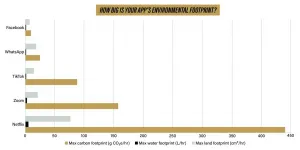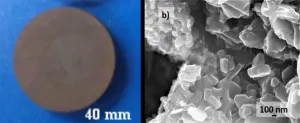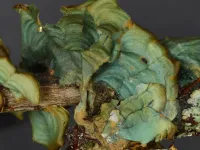(Press-News.org) WEST LAFAYETTE, Ind. -- It's not just to hide clutter anymore - add "saving the planet" to the reasons you leave the camera off during your next virtual meeting.
A new study says that despite a record drop in global carbon emissions in 2020, a pandemic-driven shift to remote work and more at-home entertainment still presents significant environmental impact due to how internet data is stored and transferred around the world.
Just one hour of videoconferencing or streaming, for example, emits 150-1,000 grams of carbon dioxide (a gallon of gasoline burned from a car emits about 8,887 grams), requires 2-12 liters of water and demands a land area adding up to about the size of an iPad Mini.
But leaving your camera off during a web call can reduce these footprints by 96%. Streaming content in standard definition rather than in high definition while using apps such as Netflix or Hulu also could bring an 86% reduction, the researchers estimated.
The study, conducted by researchers from Purdue University, Yale University and the Massachusetts Institute of Technology, is the first to analyze the water and land footprints associated with internet infrastructure in addition to carbon footprints. The findings are published in the journal Resources, Conservation & Recycling.
"If you just focus on one type of footprint, you miss out on others that can provide a more holistic look at environmental impact," said Roshanak "Roshi" Nateghi, a Purdue professor of industrial engineering, whose work looks to uncover gaps and assumptions in energy research that have led to underestimating the effects of climate change.
A number of countries have reported at least a 20% increase in internet traffic since March. If the trend continues through the end of 2021, this increased internet use alone would require a forest of about 71,600 square miles - twice the land area of Indiana - to sequester the emitted carbon, the study found.
The additional water needed in the processing and transmission of data would also be enough to fill more than 300,000 Olympic-size swimming pools, while the resulting land footprint would be about equal to the size of Los Angeles.
The team estimated the carbon, water and land footprints associated with each gigabyte of data used in YouTube, Zoom, Facebook, Instagram, Twitter, TikTok and 12 other platforms, as well as in online gaming and miscellaneous web surfing. As expected, the more video used in an application, the larger the footprints.
Because data processing uses a lot of electricity, and any production of electricity has carbon, water and land footprints, reducing data download reduces environmental damage.
"Banking systems tell you the positive environmental impact of going paperless, but no one tells you the benefit of turning off your camera or reducing your streaming quality. So without your consent, these platforms are increasing your environmental footprint," said Kaveh Madani, who led and directed this study as a visiting fellow at the Yale MacMillan Center.
The internet's carbon footprint had already been increasing before COVID-19 lockdowns, accounting for about 3.7% of global greenhouse gas emissions. But the water and land footprints of internet infrastructure have largely been overlooked in studies of how internet use impacts the environment, Madani said.
Madani teamed up with Nateghi's research group to investigate these footprints and how they might be affected by increased internet traffic, finding that the footprints not only vary by web platform, but also by the country. The team gathered data for Brazil, China, France, Germany, India, Iran, Japan, Mexico, Pakistan, Russia, South Africa, the U.K. and the U.S.
Processing and transmitting internet data in the U.S., the researchers found, has a carbon footprint that is 9% higher than the world median, but water and land footprints that are 45% and 58% lower, respectively.
Incorporating the water and land footprints of internet infrastructure painted a surprising picture for a few countries. Even though Germany, a world renewable energy leader, has a carbon footprint well below the world median, its water and land footprints are much higher. The country's energy production land footprint, for example, is 204% above the median, the researchers calculated.
Purdue graduate students Renee Obringer, Benjamin Rachunok and Debora Maia-Silva performed the calculations and data analysis in collaboration with Maryam Arbabzadeh, a postdoctoral research associate at MIT. The estimates are based on publicly available data for each platform and country, models developed by Madani's research group and known values of energy use per gigabyte of fixed-line internet use.
The estimates are rough, the researchers say, since they're only as good as the data made available by service providers and third parties. But the team believes that the estimates still help to document a trend and bring a more comprehensive understanding of environmental footprints associated with internet use.
"These are the best estimates given the available data. In view of these reported surges, there is a hope now for higher transparency to guide policy," Nateghi said.
INFORMATION:
The study was supported by the Purdue Climate Change Research Center, the Purdue Center for the Environment, the MIT Energy Initiative and the Yale MacMillan Center.
ABSTRACT
The Overlooked Environmental Footprint of Increased Internet Use
Renee Obringer1,2, Benjamin Rachunok3*, Debora Maia-Silva2*, Maryam
Arbabzadeh4*, Roshanak Nateghi3, Kaveh Madani5,6
1The National Socio-Enviromental Synthesis Center, University of Maryland, 1 Park
Place, Annapolis, MD 21401 USA
2Environmental and Ecological Engineering, Purdue University, 500 Central Drive, West
Lafayette, IN 47907 USA
3School of Industrial Engineering, Purdue University, 315 N. Grant Street, West Lafayette,
IN 47907 USA
4Massachusetts Institute of Technology Energy Initiative, 307 Ames Street E19,
Cambridge, MA 02142 USA
5Department of Political Science, Yale University, 115 Prospect Street, New Haven, CT
06520 USA
6Centre for Environmental Policy, Imperial College London, 16-18 Princes Gardens,
London SW7 1NE, UK
*These authors contributed equally to this work.
DOI: 10.1016/j.resconrec.2020.105389
The environmental costs of adopting new technologies and habits are often recognized too late, typically when changing the adopted technologies and behavioral norms is difficult. A similar story may unfold if society continues to blindly transition to an unregulated and environmentally unaudited digital world, a transition path that has been facilitated by the fourth industrial revolution and is now accelerated by the global COVID-19 crisis. The newly developed digital lifestyle has major environmental benefits, including the reduction of travel-related CO2 emissions. Yet, increased Internet use has some hidden environmental impacts that must be uncovered (Figure 1a) to make the transition to a low-carbon and green economy successful.
January 14, 2021 - Orthopaedic surgeons have traditionally been taught that certain types of knee symptoms indicate damage to specialized structures called the menisci. But these "meniscal" and "mechanical" symptoms do not reflect what surgeons will find at knee arthroscopy, reports a study in The Journal of Bone & Joint Surgery. The journal is published in the Lippincott portfolio in partnership with Wolters Kluwer.
Both types of symptoms are strongly related to the overall amount of cartilage damage in the knee joint - but not to the presence of meniscal tears, according to the new research ...
In today's economy, American businesses often tap into professional management to grow, but most firms in India and other developing countries are family owned and often shun outside managers. A new study co-authored by Yale economist Michael Peters explores the effects that the absence of outside professional management has on India's businesses and the country's economy.
The study, published in the American Economic Review, uses a novel model to compare the relationship between the efficiency of outside managers and firm growth in the United States and India. It shows ...
Genome analysis can provide information on genes and their location on a strand of DNA, but such analysis reveals little about their spatial location in relation to one another within chromosomes -- the highly complex, three-dimensional structures that hold genetic information.
Chromosomes resemble a fuzzy "X" in microscopy images and can carry thousands of genes. They are formed when DNA winds around proteins -- called histones -- which are further folded into complexes called chromatin, which make up individual chromosomes.
Knowing which genes are located in spatial proximity within the chromatin is important because genes that are near each other generally work together.
Now, researchers at the END ...
Computational materials science experts at the U.S. Department of Energy's Ames Laboratory enhanced an algorithm that borrows its approach from the nesting habits of cuckoo birds, reducing the search time for new high-tech alloys from weeks to mere seconds.
The scientists are investigating a type of alloys called high-entropy alloys, a novel class of materials that are highly sought after for a host of unusual and potentially beneficial properties. They are lightweight in relation to their strength, fracture-resistant, highly corrosion and oxidation resistant, and stand up well in high-temperature and high-pressure environments -- making them attractive materials for aerospace industry, space exploration, nuclear energy, and defense applications.
While the promise of these ...
Researchers from the PTSD Systems Biology Consortium, led by scientists from the Walter Reed Army Institute of Research, have identified distinct biotypes for post-traumatic stress disorder, the first of their kind for any psychological disorder. "These biotypes can refine the development of screening tools and may explain the varying efficacy of PTSD treatments", said Dr. Marti Jett, leader of the consortium and WRAIR chief scientist.
Publishing their work in Molecular Psychiatry in a manuscript first authored by WRAIR's Dr. Ruoting Yang, researchers used blood tests from male, combat-exposed veterans across a three year period to identify two PTSD biotypes, G1--characterized ...
TROY, N.Y. -- As cancer and tumor cells move inside the human body, they impart and are subject to mechanical forces. In order to understand how these actions affect cancer cell growth, spread, and invasion, a team of engineers at Rensselaer Polytechnic Institute is developing new models that mimic aspects of the mechanical environment within the body, providing new insight into how and why tumors develop in certain ways.
In research published today in Integrative Biology, a team of engineers from Rensselaer developed an in vitro -- in the lab -- lymphatic vessel model to study the growth of tumor emboli, collections of ...
Superconductivity already has a variety of practical applications, such as medical imaging and levitating transportation like the ever-popular maglev systems. However, to ensure that the benefits of applied superconductors keep spreading further into other technological fields, we need to find ways of not only improving their performance, but also making them more accessible and simpler to fabricate.
In this regard, magnesium diboride (MgB2) has attracted the attention of researchers since its discovery as a superconductor with multiple advantages. It is a lightweight, easily processible material made from widely abundant ...
MEDFORD/SOMERVILLE, Mass. (Jan. 14, 2021)-- Exposure to discrimination plays a significant role in the risk of developing anxiety and related disorders, even - in a first - after accounting for potential genetic risks, according to a multidisciplinary team of health researchers led by Tufts University and the Harvard T.H. Chan School of Public Health.
Researchers determined that even after controlling for genetic risk for anxiety, depression, and neuroticism, greater reports of discrimination experiences remained associated with higher scores of anxiety and related disorders. The findings, recently ...
GAINESVILLE, Fla. --- Scientists have found a new species of fleshy verdigris lichen, thanks to DNA analysis of museum specimens. Misidentified by its original collectors, the lichen is only known from 32 specimens collected in North and Central Florida scrubland between 1885 and 1985. Now the hunt is on to find it in the wild - if it still exists.
The lichen, named Cora timucua in honor of Florida's Timucua people, is critically endangered, even more so than the federally protected Florida perforate reindeer lichen, and possibly extinct. Researchers are holding out hope that C. timucua may persist in undisturbed pockets of the state's dwindling pine scrub habitat, though recent searches came up empty.
"The million-dollar question is 'Where is this lichen?'" said Laurel Kaminsky, a digitization ...
A novel new study suggests that the behavior public officials are now mandating or recommending unequivocally to slow the spread of surging COVID-19--wearing a face covering--should come with a caveat. If not accompanied by proper public education, the practice could lead to more infections.
The finding is part of an unique study, just published in JMIR Public Health and Surveillance, that was conducted by a team of health economists and public health faculty at the University of Vermont's Larner College of Medicine in partnership with public health officials for the state of Vermont.
The study combines survey data gathered from adults living in northwestern Vermont with test results that showed whether a subset of them had contracted COVID-19, a dual research ...





